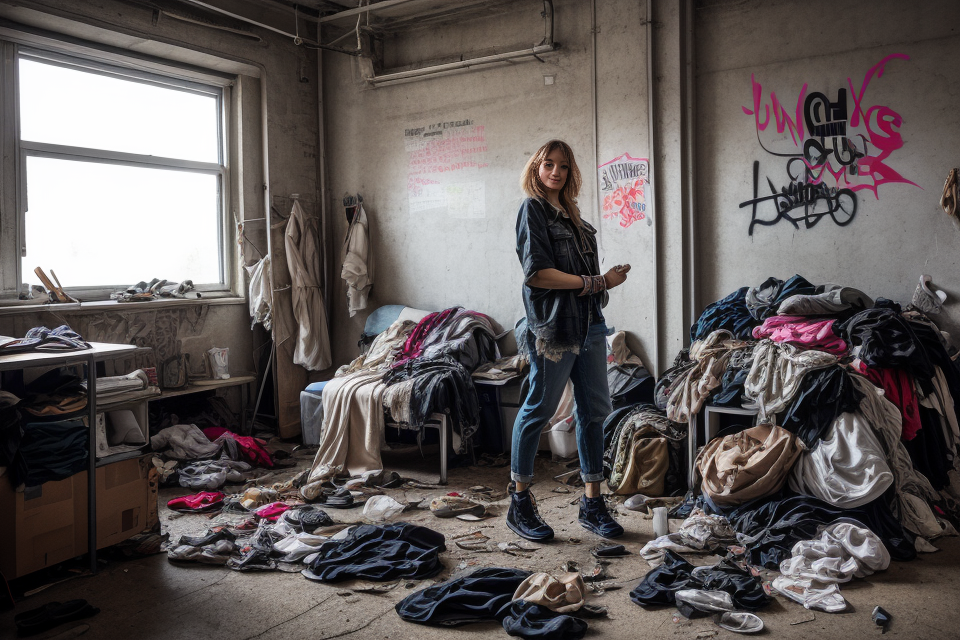
Fast fashion has taken the world by storm, with clothing becoming cheaper and more accessible than ever before. However, the rapid production and disposal of clothing has resulted in a devastating impact on the environment and society. This article will explore the environmental and social implications of fast fashion, and why sustainable fashion is a crucial issue that needs to be addressed. From pollution and waste to labor exploitation and human rights violations, the fashion industry has a dark side that cannot be ignored. We will delve into the challenges and opportunities of sustainable fashion, and why it is essential for a better future. So, join us as we uncover the truth behind fast fashion and why sustainable fashion matters.
The Problem with Fast Fashion
Overconsumption of Clothing
The Rapid Growth of Fast Fashion
Fast fashion has become a dominant force in the global fashion industry, offering trendy and affordable clothing to consumers worldwide. With the rise of fast fashion retailers such as Zara, H&M, and Forever 21, the industry has experienced rapid growth in recent years.
The Culture of Overconsumption
The fast fashion model relies on high volumes of production and rapid turnover of styles, leading to a culture of overconsumption. Consumers are encouraged to buy more clothes, discard old ones, and replace them with new trends, leading to a vicious cycle of waste and environmental degradation.
The Environmental Cost of Textile Waste
The textile industry is a significant contributor to global pollution, with fast fashion adding to the problem. According to the Environmental Protection Agency (EPA), the textile industry generates over 16 million tons of waste annually, with less than 15% being recycled. This results in significant environmental costs, including water pollution, greenhouse gas emissions, and the release of toxic chemicals into the environment.
The Social Cost of Fast Fashion
The fast fashion model also has social costs, with many workers in developing countries suffering from poor working conditions and low wages. Many fast fashion retailers outsource production to countries with low labor costs, leading to exploitation of workers and a lack of worker protections.
In conclusion, the overconsumption of clothing in the fast fashion industry has significant environmental and social costs. It contributes to textile waste, pollution, and greenhouse gas emissions, while also exploiting workers in developing countries. As a result, it is essential to promote sustainable fashion practices and support brands that prioritize environmental and social responsibility.
The Human Cost of Fast Fashion
Unethical Labor Practices
Fast fashion has been criticized for its unethical labor practices, which often involve exploiting workers in developing countries. Many fast fashion companies outsource their production to countries with low labor costs, where workers are paid poverty wages and often work in poor working conditions.
The Role of Sweatshops in the Fashion Industry
Sweatshops, which are factories that employ workers in poor working conditions, have become synonymous with the fast fashion industry. Sweatshops often operate in countries with weak labor laws and minimal oversight, allowing fast fashion companies to produce their products at a lower cost.
Child Labor
In some cases, fast fashion companies have been accused of using child labor in their supply chains. This is particularly prevalent in countries such as Bangladesh, where many garment workers are young and often work long hours for low pay.
Health and Safety Issues
Workers in fast fashion supply chains often face health and safety issues, including exposure to toxic chemicals, poor ventilation, and inadequate fire safety measures. These issues are particularly prevalent in countries such as China, where fast fashion companies have been accused of cutting corners to save costs.
Mental Health Issues
Fast fashion supply chains can also have a negative impact on the mental health of workers. Many workers experience high levels of stress and anxiety due to the fast-paced and demanding nature of their work, and some have reported experiencing depression and other mental health issues as a result.
Overall, the human cost of fast fashion is significant, and it is important for consumers to be aware of the issues involved in producing the clothing they wear. By supporting sustainable fashion brands and making more conscious purchasing decisions, consumers can help to reduce the negative impact of the fashion industry on workers and the environment.
Understanding Sustainable Fashion
Defining Sustainable Fashion
Key Principles of Sustainable Fashion
- Environmental sustainability: This refers to the minimization of the negative impact of the fashion industry on the environment, through the use of sustainable materials, reduced water and energy consumption, and the reduction of waste and pollution.
- Social sustainability: This principle focuses on ensuring that the fashion industry is socially responsible, by treating workers fairly and ensuring safe working conditions, as well as promoting diversity and inclusivity.
- Economic sustainability: This principle emphasizes the need for the fashion industry to be economically viable and sustainable, through the use of ethical business practices, fair labor practices, and sustainable supply chains.
Sustainable vs. Fast Fashion: A Comparison
- Sustainable fashion prioritizes the use of environmentally friendly materials and production methods, while fast fashion prioritizes speed and low cost.
- Sustainable fashion aims to create a circular economy, where materials are recycled and reused, while fast fashion relies on a linear economy, where materials are used once and then discarded.
- Sustainable fashion often involves transparency in the supply chain, while fast fashion often lacks transparency and may use unethical labor practices.
- Sustainable fashion aims to create timeless and versatile pieces that can be worn for a long time, while fast fashion focuses on fast trend turnover and disposable fashion.
Sustainable Materials and Production Techniques
Organic Cotton
- Organic cotton is a sustainable alternative to conventional cotton, which is often heavily reliant on pesticides and synthetic fertilizers.
- Organic cotton farming focuses on using natural methods to control pests and improve soil health, resulting in a more environmentally friendly product.
- Organic cotton farms tend to have lower carbon footprints, as they use fewer fossil fuels and promote biodiversity.
Recycled Polyester
- Recycled polyester is a sustainable alternative to traditional polyester, which is derived from non-renewable sources like oil and coal.
- Recycled polyester is made from plastic waste, such as water bottles and polyester clothing, which would otherwise end up in landfills.
- Recycling polyester requires less energy and produces fewer greenhouse gas emissions than manufacturing new polyester from virgin materials.
Upcycling and Downcycling
- Upcycling involves transforming existing materials into new, higher-quality products.
- For example, turning old t-shirts into quilts or creating new dresses from vintage fabric.
- Upcycling reduces waste and conserves resources by giving old materials a second life.
- Downcycling, on the other hand, involves breaking down materials to create lesser-quality products.
- For instance, recycling plastic bottles into fibers for insulation or carpeting.
- While downcycling also reduces waste, it is generally considered less sustainable than upcycling because the final product is of lower quality.
Sustainable Business Models
- Circular Fashion
- This model focuses on reducing waste by reusing, recycling, and repurposing materials. It aims to create a closed-loop system where waste is minimized and resources are used efficiently. Circular fashion also encourages consumers to adopt a more sustainable approach to fashion by promoting the sharing, swapping, and mending of clothes.
- Capsule Wardrobes
- A capsule wardrobe is a collection of essential, versatile, and timeless pieces that can be mixed and matched to create a variety of outfits. By focusing on quality over quantity, this approach reduces the need for excessive consumption and waste. A capsule wardrobe also encourages consumers to think more critically about their purchases and invest in pieces that are durable, versatile, and align with their values.
- Ethical and Fair Trade Brands
- Ethical and fair trade brands prioritize transparency, accountability, and social responsibility in their business practices. They ensure that their products are made under safe, fair, and legal working conditions, and often use sustainable materials and production methods. By supporting these brands, consumers can make a positive impact on the lives of workers and the environment while also expressing their values through their purchases.
Making the Switch to Sustainable Fashion
Small Changes, Big Impact
Shopping Smarter
- Consider the quality of the garment before making a purchase
- Invest in classic, timeless pieces that never go out of style
- Opt for versatile pieces that can be dressed up or down
- Choose garments made from sustainable materials such as organic cotton, recycled polyester, and Tencel
Extending the Life of Your Clothes
- Regularly check the care label to properly maintain your clothes
- Store your clothes properly to prevent damage
- Mend and alter your clothes instead of throwing them away
- Upcycle or repurpose old clothes into new pieces
Sustainable Alternatives to Fast Fashion Brands
- Look for brands that prioritize sustainability and ethical practices
- Support small, independent designers who use sustainable materials and ethical production methods
- Buy second-hand clothes from thrift stores, consignment shops, or online marketplaces
- Consider renting or swapping clothes with friends or online communities
Building a Sustainable Wardrobe
Investment Pieces
When building a sustainable wardrobe, it is essential to focus on investment pieces that are high-quality, timeless, and versatile. These pieces can be expensive initially, but they will last longer and save money in the long run. By investing in a few well-made, high-quality pieces, you can create a capsule wardrobe that is both stylish and sustainable.
Timeless Styles
Timeless styles are another key aspect of building a sustainable wardrobe. These are pieces that never go out of fashion and can be worn for years to come. Examples of timeless styles include classic dresses, tailored trousers, and plain t-shirts. By choosing timeless styles, you can avoid the need to constantly update your wardrobe and contribute to the fast fashion cycle.
Seasonal Accents
Finally, when building a sustainable wardrobe, it is important to incorporate seasonal accents. These are pieces that add a pop of color or style to your wardrobe and can be easily swapped out depending on the season. Examples of seasonal accents include statement jewelry, bright scarves, and patterned blouses. By incorporating seasonal accents into your wardrobe, you can add variety and personality to your look without contributing to the fast fashion cycle.
The Future of Fashion
The fashion industry is one of the largest polluting industries in the world, and it is essential to recognize the need for a more sustainable future. As consumers become more aware of the environmental and social impact of fast fashion, there is a growing demand for sustainable fashion options. In this section, we will explore the future of fashion and the role that sustainable fashion plays in shaping it.
The Need for Systemic Change
To achieve a more sustainable future in fashion, there is a need for systemic change. This includes addressing the root causes of the industry’s environmental and social impact, such as overconsumption, waste, and exploitation of workers. It also involves rethinking the traditional business models and supply chains that have contributed to these issues.
The Power of Consumer Choice
Consumers have the power to drive change in the fashion industry. By making conscious choices about what they buy and wear, consumers can support sustainable fashion brands and practices. This includes choosing clothes made from sustainable materials, investing in high-quality, long-lasting pieces, and participating in clothing swaps and second-hand markets.
The Role of Fashion Industry Players
Fashion industry players, including designers, brands, retailers, and manufacturers, also have a crucial role to play in shaping the future of fashion. This includes adopting more sustainable practices and materials, promoting transparency and accountability, and supporting circular economy initiatives. Collaboration and partnerships between different stakeholders can also help drive progress towards a more sustainable future.
A Call to Action for a More Sustainable Future
In conclusion, the future of fashion depends on our collective actions and choices. By making the switch to sustainable fashion, we can contribute to a more environmentally and socially responsible industry. It is time for all stakeholders to take responsibility and work together towards a more sustainable future for fashion.
FAQs
1. What is sustainable fashion?
Sustainable fashion refers to clothing and accessories that are produced in an environmentally and socially responsible manner. This includes using sustainable materials, reducing waste, and ensuring fair labor practices throughout the supply chain.
2. Why is sustainable fashion important?
Sustainable fashion is important because the traditional fashion industry has a significant negative impact on the environment and society. Fast fashion, in particular, has been criticized for its high carbon footprint, water pollution, and exploitation of workers. By choosing sustainable fashion, consumers can make a positive impact on the environment and support ethical labor practices.
3. What are some examples of sustainable materials?
Some examples of sustainable materials include organic cotton, recycled polyester, and Tencel, a plant-based fabric made from eucalyptus trees. These materials are renewable, biodegradable, and require less water and energy to produce than traditional fabrics.
4. How can I make my wardrobe more sustainable?
There are several ways to make your wardrobe more sustainable. One is to buy high-quality, timeless pieces that will last longer and require less frequent replacement. Another is to shop secondhand or vintage, which reduces waste and supports sustainable fashion. You can also try to repair and upcycle your existing clothes, rather than throwing them away.
5. Is sustainable fashion more expensive than traditional fashion?
Sustainable fashion can be more expensive than traditional fashion, but this is often due to the higher costs of sustainable materials and ethical labor practices. However, as sustainable fashion becomes more mainstream, prices are becoming more competitive. Additionally, investing in high-quality, sustainable pieces can save money in the long run, as they are likely to last longer and require less frequent replacement.


